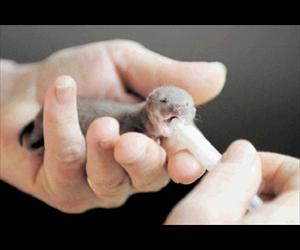Pine Marten (Martes martes)
I didn’t realise just how cute these little guys are or that they are natives to Britain.

I find it bizarre that they are not as broadcasted about as badgers, especially since they are, in my humble opinion, far more adorable. Why do the public not know more about them? As we’ve found with the badger cull, the public are willing to be extremely vocal but it’s up to us (the scientists) to make sure they get emotional about the truth and not misinformation or assumed facts.

Bearing in mind just how successful the beaver trial in Scotland is for socio-economic benefits (such as the tourism they generate), there is a real incentive for locals to support any reintroductions or ‘reinforcements’ that go on.
“Education is the most powerful weapon which you can use to change the world” – Nelson Mandela
Another interesting aspect for me is that of how interwoven conservation can be. For instance there is some conflict with that of Red Squirrel conservation. On one hand Pine Martens are carnivores and will eat Red Squirrels, but on the other they also eat Grey Squirrels. Because they didn’t evolve together they put the fear of god into the grey squirrels, ridding them of the competitive edge they had over the red squirrels.

This allows the Red Squirrels to claim back their habitat and improve the health of the forest. However many conservationists can’t get over the fact that the Pine Martens, indeed, eat some of the Red Squirrels.

There can also be a very strong accord among conservation too, as with the beaver reintroductions. When Pine Martens nest on the ground they are very vulnerable to predators; especially given their low ability to bounce back from population declines. They tend to nest higher up, preferring hollow trees. As I learnt at a different lecture beavers, by eliminating competition, allow the creation of these much needed hollow trees near the river side.

(As you can see the species is very photogenic, one could almost imagine it was posing for the camera)
Considering just how beneficial they could potentially be, with so few negatives, why have none of our governments done something about reintroducing them?
How can Great Britain preach to other countries that they should live with the problems nature creates, such as Tigers and Lions, and yet we can’t live with badgers, pine martens or beavers?
THEY DON’T EVEN EAT PEOPLE!!!

This is a well presented blog with a great use of pictures! It was an interesting read considering I didn’t attend this seminar, so it was great to read about such a similar topic to the beaver reintroduction.
It seems reintroduction is a big topic at the moment, with many animals being considered. In my opinion, from attending the beaver seminar and reading your view of the pine martens, I would say the beaver is of more importance currently to be reintroduced over the Pine marten. This is because the beaver creates many habitats not just for itself but for other animals such as otters, water voles and invertebrates and is a herbivore which means any disruption of food chains is very minimal. The fact the pine marten could be eating red squirrels is a worry as they need all the help they can get in surviving as it is!
As stated in this fact sheet brought by the Scottish Natural heritage, http://www.snh.org.uk/pdfs/education/pinemarten.pdf, it seems there are many creatures such as small birds, frogs and rabbits which they eat which makes me wonder about how they will effect the food chain and whether they will cause conflict with other competing animals or cause a decline in their prey.
Overall a well written blog with good reasoning, it has made me read up on the subject even more!
Pingback: November comments | ElizabethHopkinson
I really enjoyed your post. It was well presented and informative. I do agree that efforts should be made in trying to preserve and, if all possible, increase the pine marten population. It is true that, recently, pine martens have received their much needed protected status, but this is not enough.
This is why conservation and reintroduction programmes, such as the one that David Bavin presented, will be crucial in restoring the populations to a sustainable size. And this milestone is achievable, as proven by the restoration programmes from Scotland and Ireland. However, it is possible that, like with the beaver reintroduction programmes, the current government may not perceive this as a pressing matter, explaining why there was no official governmental response in trying to re-establish pine marten communities in England.
In any case, the work that the people from the Vincent Wildlife Trust have done paved the way for other similar NGOs, who will hopefully join their cause in this ambitious, but necessary, project.
Pingback: I Made a Comment on This Blog | Why Do We Love Science
Pingback: November Comments | Why Do We Love Science